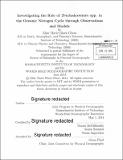Investigating the role of Trichodesmium spp. in the oceanic nitrogen cycle through observations and models
Author(s)
Olson, Elise Marie Black
DownloadFull printable version (16.69Mb)
Other Contributors
Woods Hole Oceanographic Institution.
Advisor
Dennis McGillicuddy.
Terms of use
Metadata
Show full item recordAbstract
This work concerns the nitrogen fixation and abundance of Trichodesmium colonies in the western subtropical-tropical North Atlantic and their connections with physical processes. Data were collected in fall 2010 and spring 2011, primarily using the Video Plankton Recorder (VPR). A data processing procedure for estimating the abundance of rare taxa was devised to take advantage of the accuracy of manual classification and the effort savings of automatic classification. The procedure entails selecting a subset of the original dataset, classifying it with automated software, and then manually correcting each classification. The method was validated through comparisons with fully classified VPR data and with abundance data based on microscopic enumeration on preserved samples. Correlations of Trichodesmium colony abundance with the eddy field emerged in two subsets of the VPR observations. In fall 2010, local maxima in abundance were observed in a series of cyclones. We hypothesized Ekman transport convergence/ divergence in cyclones/anticyclones as a driving mechanism. We investigated the process using idealized three-dimensional models of buoyant colonies in eddies. Elevated abundances in anticyclones in spring 2011 were correlated with anomalously fresh water, suggesting riverine input as a driver of the relationship. Finally, we evaluated the hypothesis of Davis and McGillicuddy (2006) that Trichodesmium nitrogen fixation in the North Atlantic may be underestimated by conventional sampling methods, based on their VPR observations of higher than expected colony abundances at depth in the subtropical North Atlantic. A bio-optical model was developed based on carbon-normalized nitrogen fixation rates measured in fall 2010 and spring 2011 and used to estimate nitrogen fixation over the VPR transects. Estimates of abundance and nitrogen fixation were similar in magnitude and vertical and geographical distribution to estimates compiled in a database by Luo et al. (2012). In the mean, VPR-based estimates of volume-specific nitrogen fixation rates at depth in the tropical North Atlantic were not inconsistent with estimates derived from conventional sampling methods. Based on this analysis, if Trichodesmium nitrogen fixation is underestimated, it is unlikely that it is attributable to underestimation of deep colony abundances due to mechanical disturbance during net-based sampling.
Description
Thesis: Ph. D., Joint Program in Physical Oceanography (Massachusetts Institute of Technology, Department of Earth, Atmospheric, and Planetary Sciences; and the Woods Hole Oceanographic Institution), 2014. Cataloged from PDF version of thesis. Includes bibliographical references (pages 155-162).
Date issued
2014Department
Joint Program in Physical Oceanography; Woods Hole Oceanographic Institution; Massachusetts Institute of Technology. Department of Earth, Atmospheric, and Planetary SciencesPublisher
Massachusetts Institute of Technology
Keywords
Joint Program in Physical Oceanography., Earth, Atmospheric, and Planetary Sciences., Woods Hole Oceanographic Institution.